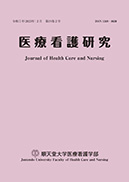Current issue
Displaying 1-10 of 10 articles from this issue
- |<
- <
- 1
- >
- >|
Feature Article
-
Article type: Feature Article
2024 Volume 20 Issue 2 Pages 1-13
Published: 2024
Released on J-STAGE: March 03, 2024
Download PDF (1379K)
Original Article
-
Article type: Original Article
2024 Volume 20 Issue 2 Pages 14-23
Published: 2024
Released on J-STAGE: March 03, 2024
Download PDF (1536K) -
Article type: Original Article
2024 Volume 20 Issue 2 Pages 24-32
Published: 2024
Released on J-STAGE: March 03, 2024
Download PDF (1086K) -
Article type: Original Article
2024 Volume 20 Issue 2 Pages 33-43
Published: 2024
Released on J-STAGE: March 03, 2024
Download PDF (1454K) -
Article type: Original Article
2024 Volume 20 Issue 2 Pages 44-54
Published: 2024
Released on J-STAGE: March 03, 2024
Download PDF (838K)
Research Report
-
Article type: Research Report
2024 Volume 20 Issue 2 Pages 55-65
Published: 2024
Released on J-STAGE: March 03, 2024
Download PDF (1460K) -
Article type: Research Report
2024 Volume 20 Issue 2 Pages 66-76
Published: 2024
Released on J-STAGE: March 03, 2024
Download PDF (1422K) -
Article type: Research Report
2024 Volume 20 Issue 2 Pages 77-86
Published: 2024
Released on J-STAGE: March 03, 2024
Download PDF (1582K) -
Article type: Research Report
2024 Volume 20 Issue 2 Pages 87-95
Published: 2024
Released on J-STAGE: March 03, 2024
Download PDF (1408K)
Material
-
Article type: Material
2024 Volume 20 Issue 2 Pages 96-104
Published: 2024
Released on J-STAGE: March 03, 2024
Download PDF (1405K)
- |<
- <
- 1
- >
- >|
